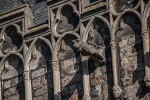Crimea_River
Marshal
Interesting post Grant. I remember seeing a documentary on those tunnels told from a Canadian perspective. Many of the soldiers, waiting underground for the battle to start, carved their names and poignant messages in the walls and these can still be seen.

